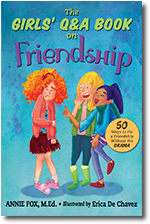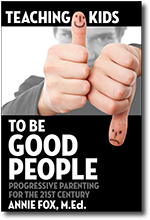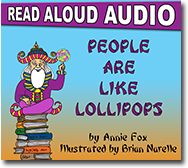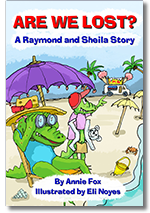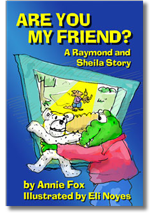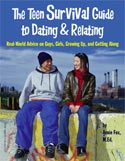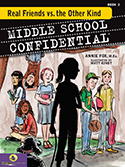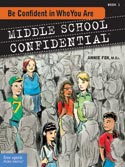May 2006
Real Friends vs. the Other Kind
by Annie Fox, M.Ed

When our kids are little, we actively teach them the importance of being nice to others. Most 2-3 year olds have repeatedly been commanded to “Share!” They usually comply—not because they’re altruistic by nature, but because they know they’ll catch it from Mom if they don’t. As parents and as members of society, we have a vested interest in teaching children empathy, compassion, etc. But what happens to those lessons when they get older?
As friends play an increasingly vital and complex role in adolescents’ lives, we should continue discussing these issues. But for some reason, parents of middle and high school kids don’t often talk about what it takes to be a good friend and how to stand up for yourself when you’re not being treated with respect.
 Tina and Danielle have been best friends since 2nd grade. Now as 6th graders, Danielle has been hanging out
with the popular girls. Monday at lunch, Danielle was with her new friends. Tina tried talking to her, but Danielle
made some joke about Tina’s shoes and all the other girls laughed. That hurt, but Tina pretended it didn’t
bother her. On Tuesday Danielle ignored her old friend completely. At the end of the day Tina got up the courage
to ask what was going on. Danielle just smiled sweetly and said, “What are you talking about?” Tina
thought that maybe she imagined the whole thing. On Wednesday morning, a couple of popular girls asked Tina why
she was being so mean to Danielle. Tina’s heart pounded as she denied it. The girls exchanged a knowing look
and walked away. By lunch Tina’s fate was sealed – not one girl in the 6th grade girl would talk to
Tina.
Tina and Danielle have been best friends since 2nd grade. Now as 6th graders, Danielle has been hanging out
with the popular girls. Monday at lunch, Danielle was with her new friends. Tina tried talking to her, but Danielle
made some joke about Tina’s shoes and all the other girls laughed. That hurt, but Tina pretended it didn’t
bother her. On Tuesday Danielle ignored her old friend completely. At the end of the day Tina got up the courage
to ask what was going on. Danielle just smiled sweetly and said, “What are you talking about?” Tina
thought that maybe she imagined the whole thing. On Wednesday morning, a couple of popular girls asked Tina why
she was being so mean to Danielle. Tina’s heart pounded as she denied it. The girls exchanged a knowing look
and walked away. By lunch Tina’s fate was sealed – not one girl in the 6th grade girl would talk to
Tina.
What had Tina done to turn everyone against her? She’d broken a cardinal rule of girl friendships: No matter how much your friend hurts you, do NOT talk honestly to her about it or you risk losing all your friends.
What happened to being assertive? What happened to self-respect? What can parents do to help their daughters stand up for themselves?
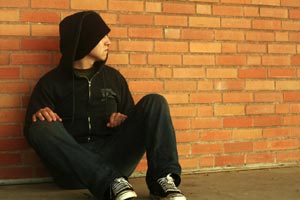 I get tons of email from
young people suffering at the hands of so-called friends. Just like their confusion about the Boyfriend/Girlfriend
Zone tweens
and young teens don’t understand how to maintain a healthy friendship. They pour out their hearts with tales
of woe:
I get tons of email from
young people suffering at the hands of so-called friends. Just like their confusion about the Boyfriend/Girlfriend
Zone tweens
and young teens don’t understand how to maintain a healthy friendship. They pour out their hearts with tales
of woe:
- “My friends aren’t really my friends”
- “I don’t know why they hate me”
- “My friend posted nasty things about me”
- “They said I was gay”
We’ve all had some friendship betrayals. Most of mine happened in 6th and 7th grade and they were devastating. So I can genuinely empathize with the kids. But that’s not much help. The only real help any caring adult can provide is letting kids know that they have choices. Silence is a choice. Pretending things are “fine” when they’re not, is a choice. Staying in an abusive friendship is also a choice and so is seeking revenge. Until kids realize that they’re making unhealthy choices and wake up to the alternatives, they’re going to feel stuck—stuck in unhappy friendships and/or cornered into nasty feuds.
In January I began teaching a new series of Workshops for the Girl Scouts of the San Francisco Bay Area. I’ve created a live, interactive learning experience to help 4-8th graders understand that maintaining healthy friendships requires a set of skills. By practicing the skills and realizing that both friends must be equally committed to the friendship, kids can:
- recognize the characteristics of a good friend
- assess the health of their friendships in terms of 2-way trust, respect, honesty, support, open communication
- speak up when a friendship goes off track and take the appropriate and socially responsible action
- work with a friend (whenever possible) to resolve conflicts in healthy ways that support the well-being of each friend and the general well-being of the friendship
NOTE: While girls’ friendship problems can often be complex and emotionally draining, boys’ friendships at this age can also cause hurt feelings. Just because your daughter talks about it more, doesn’t necessarily mean that your son has no friendship dilemmas… he may.
The response to these all-girl workshops has been great. Girls love what they’ve learned. Moms in particular understand how painful it is to be excluded by “the group” or abandoned by a friend, so they’re thrilled to have some new language and context to help their daughters do a better job navigating friendships.
Because summer offers kids more time with their friends, here are some tips to help you help your daughters and sons resolve the inevitable issues that will come up.
Dealing with Friendship Challenges
 (click for larger image) Annie and her son Ezra calm down at the foot of Yosemite's Bridal Veil Falls (though you can do it anywhere). |
- Show that you get it. Acknowledge that it hurts when someone betrays you—especially when a trusted friend turns against you. Reflect back what you hear, “You sound really hurt, angry, and confused.” Share one of your own “hurt by a friend” stories from your tween years. Hopefully you can also share what you learned from that situation and how you used it to become a stronger, more thoughtful person. This models empathy and also reassures your child that (s)he will survive.
- Calm Down. Before moving toward the conflict resolution steps (3 and 4) your child needs to de-stress and you may need to also. No matter what awful thing someone has done to your kid, calming down first makes it easier to get through the upset.
- What Can/Can’t You Control? Point out the reality: You can’t control a friend’s behavior or feelings, but you can get a handle on your own. As one very wise 12-year girl in one of my workshops said when talking about the choices other people make: “That stuff is just out of your hands.” Exactly right. And if you try to control things that you can’t control, it’s only going to stress you out more. Don’t let your kid go there!
- You’ve got options! Help your child realize that even after a fight, she’s far from powerless. She has
options that are totally within her control.
If, for example, a friend has turned into an enemy, your child’s options for dealing with the situation might include:  Talk to another trusted friend about the situation and get her opinion/advice
Talk to another trusted friend about the situation and get her opinion/advice- Talk directly to the wayward friend and tell her how what she did makes you feel
- Don’t ever talk to that friend again
- Get back at her by getting other people to turn against her
- Forget about the hurt and act like it didn’t bother you
- Find some new friends
Brainstorming at this point should be open-ended. Even though you might hear an option that immediately smacks
as a “terrible” idea, don’t say anything. Only after your child lists several options is it time
to evaluate them. Take option D, for example. Encourage your child to think about what’s likely to happen as
a result of choosing that. (The whole grade takes sides. The fight escalates, etc.) Now you can ask her: “Will
that help heal the friendship? Will it create more or less stress for you and others? What about Option E? What might
happen then? (It might send the message: What you did is OK with me. Hurt me whenever you like.) Will that build
more trust in the friendship? Help you get more respect?”
Thinking about potential consequences is incredibly valuable to adolescents because they often react without first reflecting.
So even the worst, knee-jerk options offer great (and totally safe) learning opportunities. In addition, you give your child
a gift by talking about all of this. With your support in considering options (and without worrying that you’ll rush
in and try to “fix” her problem) her thinking process will be accelerated. Hopefully, she’ll also move
closer to the time when she no longer tolerates disrespectful behavior from anyone.
At the end of the process if your child decides to end a friendship with someone who continuously causes her harm, then that would be a healthy move. But just because she’s finished with a friendship, doesn’t mean that she has the right to make life unhappy for an ex-friend. The way I put it to the kids is this: You don’t have to be friends with everyone. But it’s NEVER okay to intentionally hurt someone. Keep your distance if you choose, but always be polite, respectful, and treat others the way you want to be treated. Old rule. Still works.
In friendship,
Annie




